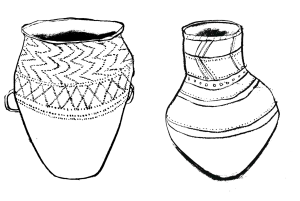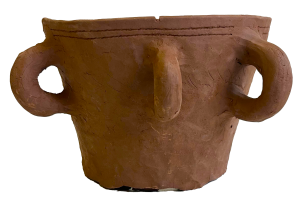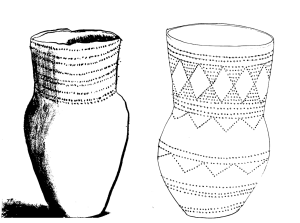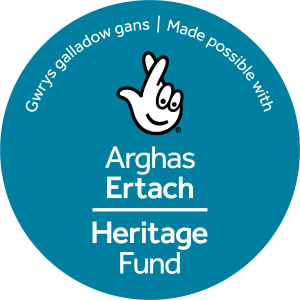Gabbroic Pottery

What is gabbroic pottery?
Gabbroic pottery is a unique type of pottery made from gabbroic clay, which comes from a type of rock called gabbro. Gabbro is a dark, dense rock with crystals big enough to see with the naked eye. It is an igneous rock, which means it was formed through the cooling and solidification of magma or lava from the earth’s mantle or crust. The rock turned into clay over a long period of time by being broken down into smaller particles through a process called weathering. People who lived in Cornwall during the Neolithic period made lots of pots from gabbroic clay. Some crystals from the rock are still visible in these pots as little white flecks in the clay, so some people say the clay looks a bit like a Hobnob biscuit!

Why is it special?
Gabbroic clay is found only on the Lizard peninsula in Cornwall, and only in a small area there (around 7km²) near the village of St Keverne. The clay lies between 20 and 45 centimetres below the surface. Despite there being other types of clay all over Cornwall, gabbroic clay was the only clay used in Cornwall for 4,000 years. And it wasn’t just used in Cornwall – gabbroic pottery has been found as far afield as Hembury Hill in Devon, Maiden Castle in Dorset, and Windmill Hill in Wiltshire!
← This excellent video introduction was commissioned by the Museum of Cornish Life.
Archaeologists aren’t entirely sure why it was the only clay used for so long. Originally, they thought it might be because it had qualities that made it easier to fire or better to use for making vessels and cooking pots than other types of clay. However, a growing number of archaeologists now believe that there may have been other reasons – perhaps the clay, or the place the clay was dug up, held some kind of spiritual significance. People might have made a special journey, like a pilgrimage, to the unique landscape of the Lizard peninsula to gather or trade clay to take home with them. Archaeologists think the clay was probably transported raw and made into pots later, rather than being made into pots where it was dug up.


Trevisker Ware pottery sherds, circa 1400, on display at the Museum of Cornish Life
How was it made?
Pots made from gabbroic clay were all shaped by hand, rather than on a potter’s wheel. A round slab of clay would be made to form the base of the pot and then snakes of clay would be coiled around the edges, building up to form the sides of the pot. These coils would be gently pinched together, giving them the name ‘pinch pots’. These would likely have been fired in a wood-fueled kiln, making them strong and resistant to heat so they could be used for cooking and storing food. The process would take a long time – around five hours in the fire and then another eighteen hours for the pots to cool down again.
Because Neolithic people made everything by hand, they put a lot of care and attention into the things they made, so their pots often had intricate patterns and textures on them. They would have used natural tools such as shells, bone, flint, rawhide, pebbles and wooden paddles to build, shape, and decorate their pots. Pebbles and wooden paddles were good for ‘burnishing’, which means to make the surface appear shiny through polishing. Not only would this make the pot nice and smooth, it also decreased the chance of it breaking while it was being fired. Shells, bone, flint, and rawhide were good for decorating – they would be used to draw or press into the surface to make different patterns. Another tool used for decorating was something called a ‘bow’, a simple construction of a piece of twine stretched between two ends of a bent stick, that made it possible to press long straight lines into the clay.

Hannah Lawrence is an expert pinch potter who lives in Cornwall, not far from the Lizard peninsula. Her methods of making pottery are very similar to the techniques used by the Neolithic potters who worked with gabbroic clay. In November 2023 Hannah was part of a team of potters and learning specialists who delivered an Art Lab for local primary school children to learn about the special history of this local clay. In this video, shot during the Art Lab, she explains her own approach to ‘experimental archaeology’ and demonstrates techniques for making and decorating pottery in Neolithic style.
Where can I see examples of gabbroic pottery?
The best place to see a real example is the Museum of Cornish Life, right next door to CAST in the centre of Helston. As well as whole pots with intricate decoration, the Museum has a handling collection including fragments that can be loaned to schools so children can touch and feel real examples of ancient pottery.
The Royal Cornwall Museum in Truro has an excellent display of local artefacts including examples of Neolithic pottery. And there’s also a very fine Neolithic vessel made of gabbroic clay in the collection of RAMM in Exeter. It was found on Hembury Hill in Devon and is known as the Hembury Bowl.

Gabbroic pot found at the Kynance Gate archaeological site, on display at the Museum of Cornish Life
This resource page was made possible by a National Lottery Heritage Fund grant.


